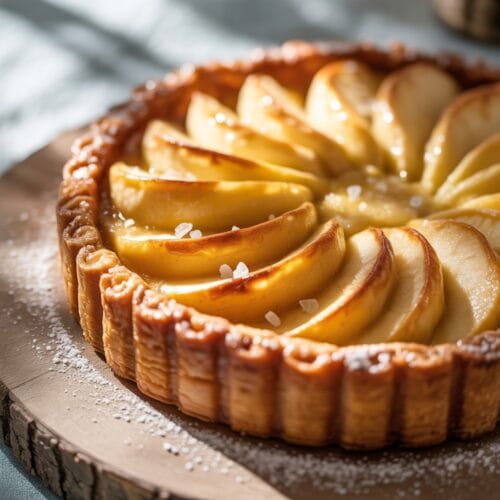
Apple Tart
A classic Apple Tart featuring thin slices of sweet-tart apples arranged in an elegant pattern atop a buttery, crisp pastry crust, finished with a warm apricot glaze that creates a stunning, professional shine.
Ingredients
- 1 ½ cups all-purpose flour
- 3 tablespoons granulated sugar
- ¼ teaspoon salt
- ½ cup 1 stick cold unsalted butter, cut into small cubes
- 4-5 tablespoons ice water
- 4-5 medium apples preferably a mix of sweet and tart varieties like Honeycrisp and Granny Smith
- ⅓ cup granulated sugar for sprinkling
- 2 tablespoons cold unsalted butter cut into tiny pieces
- ¼ cup apricot jam
- 1 tablespoon water
- Optional: 1 teaspoon cinnamon
- Optional: 1 tablespoon lemon juice
Instructions
- Prepare the pastry dough by combining flour, 3 tablespoons sugar, and salt in a large bowl. Cut in the cold butter using a pastry cutter or your fingertips until the mixture resembles coarse crumbs with some pea-sized pieces remaining.
- Add ice water one tablespoon at a time, stirring gently with a fork until the dough just begins to come together. Be careful not to overwork the dough—this ensures your crust will be flaky.
- Form the dough into a disk, wrap it in plastic, and refrigerate for at least 30 minutes or up to 2 days. This resting period allows the gluten to relax and the butter to chill properly.
- Preheat your oven to 400°F (200°C) and position a rack in the center. If using a baking sheet, line it with parchment paper.
- Core and slice the apples thinly (about ⅛ inch thick), keeping the skin on for color and texture. If using lemon juice, toss the slices with it to prevent browning.
- Roll out the chilled dough on a lightly floured surface into a 12-inch circle about ⅛ inch thick. Transfer to your tart pan or baking sheet.
- Arrange apple slices in an overlapping pattern, starting from the outside and working toward the center, leaving about a 1.5-inch border around the edge.
- Fold the pastry border over the edge of the apples, pleating as necessary to create a rustic look. The center of the tart should remain open with the fruit visible.
- Sprinkle the arranged apples with the remaining sugar and cinnamon (if using), then dot with the 2 tablespoons of butter pieces.
- Bake for 45-50 minutes until the crust is golden brown and the apples are tender and caramelized at the edges. Rotate the pan halfway through for even browning.
- Prepare the glaze by heating the apricot jam with 1 tablespoon of water in a small saucepan until it becomes liquid, then strain if chunky.
- Brush the warm glaze over the apples immediately after removing the tart from the oven for a beautiful shine and added flavor.
- Allow the tart to cool for at least 15 minutes before slicing to let the juices set slightly. Serve warm or at room temperature.
Notes
- For the most flavorful result, use a mix of apple varieties—some sweet (like Fuji or Gala) and some tart (like Granny Smith).
- The pastry dough can be made up to 2 days in advance and kept refrigerated.
- If you don’t have apricot jam for the glaze, try orange marmalade or even warmed honey as alternatives.
- For extra richness, you can brush the crust with a beaten egg before baking.
- If your kitchen is warm, chill the assembled tart for 15 minutes before baking to help maintain the crust’s structure.